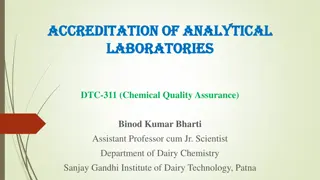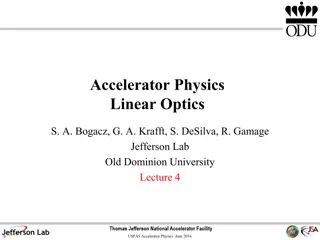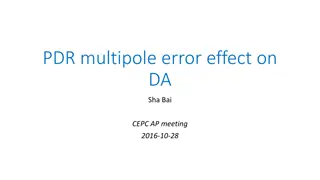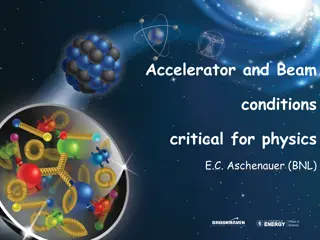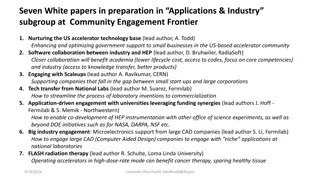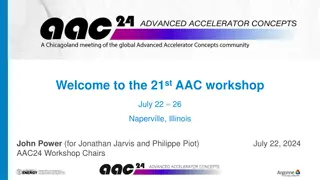Accelerator Science and Beam Physics Research Overview at US National Laboratories
US high-energy physics faces budget challenges despite the need for support to remain competitive. John Power from Argonne National Laboratory discusses the importance of funding for core research and accelerator science. The GARD program in the Department of Energy Office of High Energy Physics provides funds for medium- and long-term accelerator research, aiming to address technology gaps. Collaboration between national laboratories and universities is crucial for advancing accelerator and beam physics research in the US.
Download Presentation

Please find below an Image/Link to download the presentation.
The content on the website is provided AS IS for your information and personal use only. It may not be sold, licensed, or shared on other websites without obtaining consent from the author.If you encounter any issues during the download, it is possible that the publisher has removed the file from their server.
You are allowed to download the files provided on this website for personal or commercial use, subject to the condition that they are used lawfully. All files are the property of their respective owners.
The content on the website is provided AS IS for your information and personal use only. It may not be sold, licensed, or shared on other websites without obtaining consent from the author.
E N D
Presentation Transcript
TWO TALKS IN ONE GARD ACCELERATOR AND BEAM PHYSICS & GARD TEST FACILITIES JOHN POWER Argonne National Lab 2021 AF1 community meeting November 22, 2021
US HIGH-ENERGY PHYSICS FACES COMPOUNDING BUDGET TENSIONS US Accelerator Science requires support to remain competitive. Physics Today article (https://physicstoday.scitation.org/do/10.1063/PT.6.2.20211119a/full/ ) Despite officials desire to strengthen support for core research and accelerator and detector R&D, much of DOE s high-energy physics program funding has been spent on large projects, including the LBNF/DUNE neutrino experiment. John Power (ANL) 11/22/21
GARD ACCELERATOR AND BEAM PHYSICS THE ABP ROADMAP GARD ABP Roadmap task force. Chairs: S. Nagaitsev (Fermilab/UChicago) & Z. Huang (SLAC/Stanford) Organizing committee: J. Power (ANL), J.-L. Vay (LBNL), L. Spentzouris (IIT), P. Piot (NIU/ANL) J. Rosenzweig (UCLA) John Power for S. Nagaitsev
ACCELERATOR SCIENCE ACROSS THE DOE See Eric Colby s talk at https://aacseminarseries.lbl.gov/program/oral-program 4 John Power (ANL) 11/22/21
ACCELERATOR SCIENCE ACROSS THE US NSF Center for Bright Beams CBB's overarching research goal is to increase the intensity ("brightness") of beams by two orders of magnitude while decreasing the cost of key accelerator technologies. collaborative research with national laboratories and companies research into instruments that advance the frontiers of knowledge in life sciences, materials science, condensed matter physics, particle physics, and nuclear physics. DOE General Accelerator Research and Development (GARD) The GARD program in the Department of Energy Office of High Energy Physics (HEP) provides most of the funds for accelerator R&Din the U.S. . GARD supports medium- and long-term accelerator R&D, and the facilities to support that R&D. DOE GARD as a whole is to address Technology Gaps for HEP. Proposal driven accelerator science. We are to bring to DOE/NSF proposals for research and they respond (with guidance, requirements, and/or funding) Accelerator scientists (like all scientists) should be continuously proposing new ideas and experiments ABP proposals should address both Knowledge gaps and Technology gaps in Accelerator and Beam Physics. John Power (ANL) 11/22/21
6 Programmatic Thrust (AF6) ABP (AF1) (AF7) Test Facility Operations The GARD thrusts support research efforts at DOE national labs and universities John Power (ANL)
NSF-FUNDED CENTER FOR BRIGHT BEAMS (CBB) NSF-CBB 3 research themes = DOE-GARD 5 thrusts
THE 2014 P5 REPORT CALLED FOR AN ACCELERATOR R&D ROADMAP ABP Roadmap 2019 HEPAP presentation by J. Rosenzweig about GARD s execution of the 2014 P5 plan: https://science.osti.gov/hep/hepap/Meetings/201911
GARD reports and GARD roadmaps HEP Reports 2014 P5 report (https://www.usparticlephysics.org/) 2015 GARD Accelerator subpanel report (https://science.osti.gov/~/media/hep/hepap/pdf/Reports/Acce lerator_RD_Subpanel_Report.pdf) GARD Roadmaps (3 of 5 completed) AAC roadmap (https://science.osti.gov/~/media/hep/pdf/accelerator-rd- stewardship/Advanced_Accelerator_Development_Strategy_ Report.pdf) RF roadmap (https://science.osti.gov/~/media/hep/pdf/Reports/DOE_HEP_ GARD_RF_Research_Roadmap_Report.pdf) HF magnet roadmap (https://science.osti.gov/~/media/hep/pdf/Reports/MagnetDev elopmentProgramPlan.pdf) High-power targets (coming soon) ABP (coming soon) GARD Research Thrusts
BARRIERS THAT STAND IN OUR WAY Technology barriers Technology roadmaps exist for all areas of GARD. Physics barriers (or challenges to be overcome) In Sep 2018, we formed an ABP working group to understand these physics challenges and to formulate a strategic roadmap for the US Accelerator and Beam Physics (ABP) working group members S. Nagaitsev (Fermilab/UChicago), Z. Huang (SLAC/Stanford), J. Power (ANL), J.-L. Vay (LBNL), P. Piot (NIU/ANL), L. Spentzouris (IIT), and J. Rosenzweig (UCLA)
ABP community-driven roadmap progress 1. 2. ABP working group meetings started ~Sept 2018 Preparatory workshops: Develop community-driven physics aspirations for accelerator and beam physics information-gathering at workshops Dec 2019 at LBNL: https://conferences.lbl.gov/event/279/ Apr June 2020 (Zoom): https://indico.fnal.gov/event/22709/ Preparatory Workshops considered: Single-particle dynamics, including nonlinearities, and spin dynamics. High-brightness beam generation, transport, manipulation and cooling. Mitigation and control of collective phenomena: instabilities, space charge, beam-beam, etc Advanced accelerator instrumentation and controls. Modeling and simulation tools; fundamental theory and applied math. Early conceptual integration and optimization, maturity evaluation Connections to other GARD roadmaps; synergies with non-HEP programs
ABP community-driven roadmap ABP Workshop Report (2021) 3. ABP Preparatory Workshops Report (2021 January) Accelerator and Beam Physics Research Goals and Opportunities (https://arxiv.org/abs/2101.04107) Authors: S. Nagaitsev, Z. Huang, J. Power, J.-L. Vay, P. Piot, L. Spentzouris, J. Rosenzweig, Y. Cai, S. Cousineau, M. Conde, M. Hogan, A. Valishev, M. Minty, T. Zolkin, X. Huang, V. Shiltsev, J. Seeman, J. Byrd, Y. Hao, B. Dunham, B. Carlsten, A. Seryi, R. Patterson 4. ABP Roadmap Workshop in-person meeting (Apr 2022) ~3 days
Accelerator and beam physics ABP definition Accelerator and beam physics is the science of the motion, generation, acceleration, manipulation, prediction, observation and use of charged particle beams. The Accelerator and Beam Physics (ABP) thrust focuses on fundamental long-term accelerator and beam physics research and development. ABP vision statement: The ABP thrust explores and develops the science of accelerators and beams to make future accelerators better, cheaper, safer, and more reliable. Particle accelerators can be used to better understand our universe and to aid in solving societal challenges. Link to Workshop Report: https://arxiv.org/abs/2101.04107
timeless GARD ABP mission statement The primary scientific mission of the ABP thrust is to address and resolve the Accelerator and Beam Physics Grand Challenges Grand challenge #1 (beam intensity): How do we increase beam intensities by orders of magnitude? Grand challenge #2 (beam quality): How do we increase beam phase- space density by orders of magnitude, towards quantum degeneracy limit? Grand challenge #3 (beam control): How do we control the beam distribution down to the level of individual particles? Grand Challenge #4 (beam prediction): How do we develop predictive virtual particle accelerators ? Link to Workshop Report: https://arxiv.org/abs/2101.04107
ABP-LOI: Research needed to address the above Grand Challenges Single-particle dynamics and nonlinear phenomena; polarized-beams dynamics This impacts GC 1 and 2 and benefits from addressing GC 3 and 4. Collective effects (space-charge, beam-beam, and self-interaction via radiative fields, coherent synchrotron radiation, e.g.) and mitigation This impacts GC 1 and 2, and benefits from addressing GC 3 and 4. Beam instabilities, control, and mitigation; short- and long-range wakefields This impacts GC 1 and 2, and benefits from addressing GC 3 and 4. High-brightness / low-emittance beam generation, and high peak-current, ultrashort bunches This impacts GC 2, and benefits from addressing GC 3 and 4. Beam quality preservation and advanced beam manipulations; beam cooling and radiation effects in beam dynamics This impacts GC 2, and benefits from addressing GC 3 and 4. Advanced accelerator instrumentation and controls This impacts GC 3. High-performance computing algorithms, modeling and simulation tools This impacts GC 4. Fundamental accelerator theory and applied math This impacts all Grand Challenges. Machine learning and artificial intelligence This impacts GC 3 and 4 in the short term and GC 1 and 2 in the long term. Early conceptual integration, optimization, and maturity evaluation of accelerator concepts This focuses on science and technology gaps and bridges between various GARD thrusts. https://www.snowmass21.org/docs/files/summaries/AF/SNOWMASS21-AF1_AF7_S_Nagaitsev-056.pdf
ABP-LOI: Resources needed to address the above Grand Challenges Test facilities Currently, there are several ABP research facilities, such as FACET (SLAC), AWA (ANL), ATF (BNL), BTF (ORNL), IOTA/FAST (FNAL) and facilities at universities. Such facilities are invaluable for advancing new accelerator concepts and technologies. It is critical to maintain and enhance support for these accelerator test facilities to keep them productive for ABP. Education and training It is critical to maintain support for the existing cross-cutting educational mechanisms in the field of accelerator science and technology (e.g. USPAS). Maintaining the workforce remains a challenge; and meeting it requires the availability of specialized courses and facilities suitable for hands-on training, as well as university-based research opportunities. Integration of computational and ML tools across facilities Effective coordination, maintenance and standardization of computational and ML tool development should be encouraged. Dedicated support of this would critically benefit accelerator and beam physics modeling across facilities. https://www.snowmass21.org/docs/files/summaries/AF/SNOWMASS21-AF1_AF7_S_Nagaitsev-056.pdf
GARD TEST FACILITIES ANL-AWA BNL-ATF FNAL-FAST/IOTA LBNL-BELLA SLAC-FACT
FIVE BEAM TEST FACILITIES, SUPPORTED BY GARD IN SUPPORT OF SC MISSION: 5 GARD DOE-HEP Facilities Accelerator Test Facility (ATF*), BNL Argonne Wakefield Accelerator (AWA), ANL Berkeley Laboratory Laser Accelerator Center (BELLA), LBL Facility for Advanced Accelerator Experimental Tests II (FACET-II), SLAC Fermilab Accelerator Science and Technology facility (FAST), FNAL Mission: Provide access to a suite of complementary and diverse capabilities for a broad community of scientists representing universities, industry and National laboratories. Advance accelerator technologies for the next generation of SC research facilities Basic research in accelerator and beam physics Education and training for future scientists and engineers *ATF has been funded by GARD prior to 2013 and Accelerator Stewardship after 2013. It will move to SC-24.2 (ARDAP) in FY21.
GARD FACILITY CAPABILITIES Complementary and diverse
GARD FACILITY CAPABILITIES Complementary and diverse
EVOLUTION OF SUPPORTED CAPABILITIES Roadmaps for Advanced Concepts were developed following the previous P5 and are outlined in the 2016 DOE Advanced Accelerator Development Strategy Report These roadmaps highlight the key R&D challenges in an order of phased complexity in line with the expected availability of experimental facilities An effort to re-examine priorities, developing updated roadmaps for R&D and identifying needs for demonstration and beam test facilities is expected following upcoming P5 As advanced acceleration techniques continue to mature, as first applications will be brought online and as concepts move to the conceptual and technical design level The capabilities at each facility were developed with the focus on specific aspects of the HEP mission. Upgrade plans will be developed and coordinated to address needs of the community
GARD SUMMARY ABP and Test facilties Stakeholders scinence
Developing accelerator technologies to enable the next generation of SC- HEP science facilities GARD ABP AND TEST FACILITY GARD ABP Roadmap Identified Research to address the above Grand Challenges Test facilities Education and training Integration of computational and ML tools across facilities GARD Test Facilities Research facilities needed to address the 5 GARD Thrusts (AF1, AF6, AF7) Basic research in accelerator R&D and beam physics (AF1). Education and training for future scientists and engineers. (AF1) Worldwide competitiveness at stake (Eupraxia proposed <$600M Euro, 100M likely approved? )
HEP GARD PARTNERSHIP Stakeholders and partners (the other) HEP GARD Thrusts Advanced Accelerator Concepts Particle Sources and Targets RF Accelerator Technology (NC and SRF) SC Magnets and Materials Domestic: SC-DOE: Accelerator Stewardship, BES, NP, FES NSF: CBB National Laboratories (FNAL, SLAC, LBNL, ANL, BNL, Jlab, LANL, ) Universities (Cornell, UCLA, NIU, Stanford, IIT, U. Chicago, MSU, ) Industrial (SBIR companies) International Scientific disciplines ranging from life sciences, materials science, condensed matter physics, particle physics, and nuclear physics.



